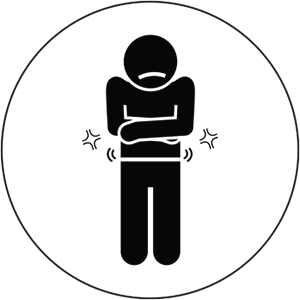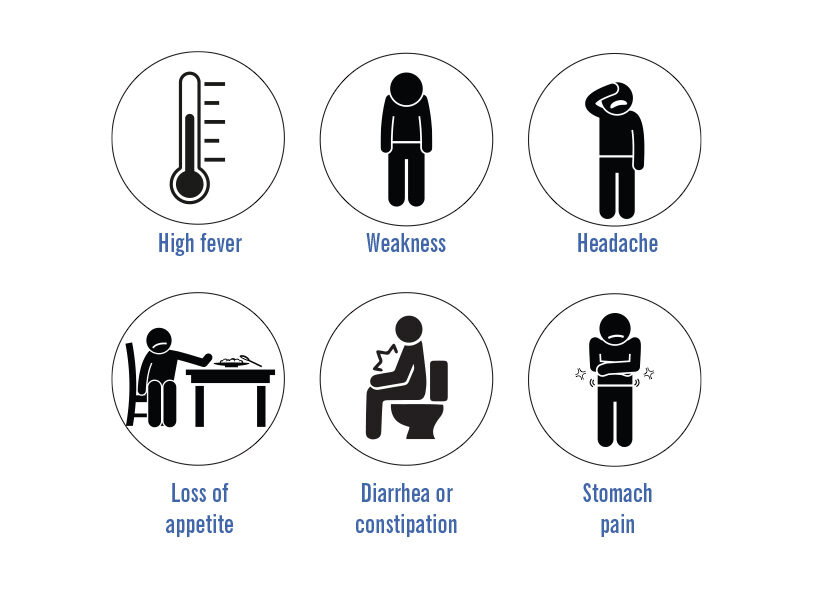
Typhoid Fever in Spokane County
In spring 2021, there was a typhoid fever outbreak in Spokane County, with seven people developing typhoid fever between March 24 and April 21 (five confirmed, two probable). Prior to this cluster, a total of two confirmed cases of typhoid fever were reported in Spokane County over the past five years. The seven recent cases had no known exposure to a diagnosed typhoid fever case or recent international travel. Contact tracing and whole genome sequencing confirmed an epidemiological link between the seven cases and connected them to a cluster of cases in Hawaii. Two of the seven cases were hospitalized.
Typhoid fever is a life-threatening illness rarely seen in countries with strong water, sanitation and hygiene infrastructure. Cases in the United States are most often associated with travel, although outbreaks have been linked to chronic carriers who shed the Salmonella Typhi bacteria in their feces long after they recover from their illness. Humans are the only animal reservoir for Salmonella Typhi. Although caused by a Salmonella bacterium, typhoid fever is clinically different from illnesses caused by non-typhoidal Salmonella subspecies. Diarrhea is typically absent and symptoms can vary from person to person. Non-specific illness symptoms such as fever, abdominal pain, chills, and nausea are the symptoms most consistently reported in typhoid fever patients.

Typhoid Fever Symptoms
Typhoid fever is confirmed when there are symptoms clinically consistent with typhoid fever and Salmonella Typhi is isolated in culture. In the early course of infection, blood cultures are as likely as stool cultures to be positive. Salmonella Typhi can also be isolated from urine cultures during systemic infection. Antibody tests for Salmonella Typhi exposure have high sensitivity and low specificity and are not generally recommended for clinical diagnoses. To be cleared by their local health jurisdiction, cases need three consecutive negative stool samples at least 24 hours apart, starting 48 hours after completing antibiotics. The reason for this timing is because people who have recovered from typhoid fever can still shed Salmonella bacilli in their stools.
Complicating typhoid fever treatment is the increase in antibiotic-resistant Salmonella Typhi bacteria. Extensively drug-resistant Salmonella Typhi has been reported in the United States, associated with travel to Iraq and Pakistan. Sensitivity testing should be performed on all Salmonella isolates to determine the appropriate course of antibiotics.
In addition to the test of cure in cases, cases’ household members need to submit stool samples to identify possible chronic carriers when there is no history of travel or other known exposures. Cases and contacts who work in childcare, food service, or health care are excluded from work until they are confirmed to no longer carry the Typhi bacteria.
Notes for Providers:
- For bloodstream and urine infections, consider a follow-up visit, antibiotic susceptibility testing or an ID referral or consult. The follow-up testing required for cases and their household members is extensive and a strong patient-provider relationship is helpful to ensure appropriate case management.
- Typhoid will show up as Salmonella with the first culture and will not be identified as typhoid until typing occurs at the Washington State Public Health Laboratories. This typically occurs 7-10 days after they receive the specimen, and by then providers may have lost contact with the patient. It may be useful to schedule follow-up appointments for any Salmonella positive until Typhi has been ruled out.
- When patients develop nonspecific illness symptoms and infectious etiology, consider diagnostic testing. Especially when the following are mentioned:
- Others with similar symptoms
- Domestic and international travel
- While some illnesses such as typhoid fever are more often associated with international travel, cases may have been exposed to ongoing outbreaks in other states
References
“Typhoid Fever and Paratyphoid Fever,” Centers for Disease Control and Prevention, August 22, 2018, https://www.cdc.gov/typhoid-fever/index.html
